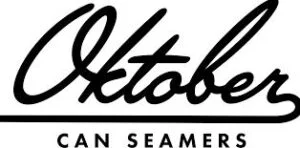OKTOBER MODEL 8 Can Seamers User Manual

Set-UP
To remove your seamer from its box, reach under and lift from under the center of the back cover as shown below. It is heavy (~50 lbs), so use caution while lifting. It’s helpful to have a second person pull the box down and off the seamer while lifting. Carry the seamer to its workstation while holding it with nearly equal weight on the back cover and under the aluminum lower receiver.
Locate your seamer on a solid, flat, and level tabletop or bar-height surface. Make sure there is enough room around the seamer to move around it easily. For uneven surfaces, the rubber feet may be used as threaded adjusters to level the seamer.
ATTENTION!!!
Canning is done in a wet environment, so always plug the seamer into a gfci (ground fault circuit interrupter) outlet to avoid shocking hazards.
OVERVIEW

SAFETY PRECAUTIONS
- Users are required to read through the entire operation manual before operating.
- Since canning is likely to create a wet environment, make sure the flooring and footwear worn around the seamer are non-slip.
- Always plug the seamer into a GFCI outlet to avoid shocking hazards.
- Pay attention to things like loose clothing, long hair, etc. The can and upper and lower chucks will be spinning and can cause injury if anything gets wrapped around them.
- Never reach into the area around the upper chuck and rollers while operating. The rollers can pinch or draw in fingers and objects and cause injury.
- Never remove the top cover while operating. The gears, spinning belt, and motor will be exposed and can cause injury.
- Never remove any machine covers while the seamer is plugged in. There are open live connections inside each that risk a shocking hazard.
REQUIREMENTS
- Rated Frequency
- Full Load Current
- 115V: 5.6amps 230V: 2.8amps Amb.
- 20C to 40C 2% to 75%rh >/=2000m bar
USAGE AND CAPABILITIES
The MODEL 8 Oktober Can Seamer is designed to seam aluminum beverage cans and size 401 steel cans and should only be used for this purpose and only with the specific can sizes and specifications indicated. Cans come in many different sizes, and the model 8 can be configured to seal many of them. Cans with the same “end” size (can top) can generally be sealed using the same “tooling” set (upper chuck, seaming rollers, base assembly).
Tooling sets are available for end sizes 200, 202, 206, 209, and 300 aluminum cans, and size 401 steel cans. Each seamer includes one tooling set. Each set comes with one or two standard lower adapters. Other lower adapters are also available, including custom adapters.
- A: Size 200 ends. Comes with a lower adapter for 250ml cans.
- B: Size 202 ends. Comes with lower adapters for 12oz and 16oz cans. (SLEEK): Size 202 ends. Comes with lower adapters for 8oz SLEEK and 12oz SLEEK cans.
- C: Size 202 ends. Comes with lower adapters for 330ml and 500ml cans.
- D: Size 202 ends. Comes with lower adapters for 19.2oz and 16oz cans.
- E: Size 206 ends. Comes with lower adapters for 24oz cans.
- F: Size 209 ends. Comes with lower adapters for 1000ml cans.
- G: Size 300 ends. Comes with lower adapters for 32oz cans.
Aluminum beverage cans and vented steel coffee cans are inteded for foodstuffs such as alcoholic beverages and roasted coffee beans and care should be taken to ensure the safety of the can’s contents. The user bears responsibility for health hazards associated with the contents.
Consideration should be taken of sanitation and food born pathogens, secondary fermentation after packaging, expiration dating, and related food safety rules and regulations including packaging regulations of alcoholic beverages. Secondary fermentation after packaging can result from residual ingredients such as sugars and/or improper sanitation before or during filling. This can result in quality issues as well as the potential to over-pressure the sealed cans leading to ruptured cans.
SEAMING
Step 1: Plug in Seamer. Step 2: Press the blue “POWER ON” switch on the left side of the seamer. The two LED lights behind the clear splash guard should illuminate. Step 3: Make sure the correct base adapter is in place for the can size you plan to use. (Base adapters generally snap onto the top of the standard adapter like a “LEGO©” piece.) Set a filled can+end onto the black plastic base adapter and lean it back into the seamer.
Step 4: Lift the splash guard handle until the can is locked in place. Step 5: Press the green “CYCLE START” button. Step 6: Once the can has finished rotating you may lower the splash guard door and remove the seamed can. NOTES: the splash guard door is equipped with a safety cycle stop switch. If you open the door during a cycle it will stop mid-cycle. Typically you can simply close the door again and push the cycle-start button one more time to complete the cycle.
DAILY MAINTENANCE
Wipe down the seamer with warm water and a rag to keep it clean of sticky residue. You can add a small amount of sanitizer or dish soap, but it is NOT suggested to use other cleaners. Warm water is all that is needed to break up sticky residues. Make sure to dry everything off thoroughly. -Make sure to empty and rinse the drip tray often to avoid spills.
WEEKLY MAINTENANCE
- Pull the base adapter off the base shaft bearing and use a rag and warm water to wipe down the bearing, washers) and wave spring (see diagram above). Dry them off add a dab of grease into the bearing and rub some onto the spring and washers). Replace them in the same order they were removed.
- Remove the base shaft by pulling out the upper quick-release pin. The shaft can then be pulled upward and out of the machine. Wipe down the shaft and the bore that the shaft rides in with water and a rag. Dry them off and rub a dab of grease onto the shaft. If this isn’t done regularly, the shaft will eventually become sticky, and the splash guard handle will become difficult to close.
CHANGING TOOLING
To change between different end sizes, you will need to swap out the upper chuck, 1st and 2nd operation rollers, the base shaft assembly, and the can guide spacers. Changing tooling sets is a simple process but it is possible to damage the seamer if done incorrectly. Pay close attention to follow the steps properly. ATTENTION!! If the tooling is assembled into the seamer incorrectly,
it can lead to the rollers crashing into the upper chuck, which can destroy the gear drive. Any time you change tooling, it is important to double check the roller clearance by pushing the roller toward the chuck by hand against the spring force until the stop screw contacts the chuck bearing. If the roller contacts the chuck before the screw contacts the bearing it may mean your rollers aren’t assembled in the correct position or you are using the incorrect rollers for the upper chuck size.

First, remove the base shaft quick release pin by pulling on the ring. This will allow the base shaft to be lifted up and out of the lower reciever. Replace it with the new base shaft assembly. To change the upper chuck, use a 3/16in hex wrench to remove the center fastener. Give the wrench a tap to get it started. Remove the roller assemblies using a 7/16in wrench. Make sure the bronze washer above the roller is also removed. When replacing the rollers, it is critical to locate them in the correct position. There are 3 tapped holes in the bottom of the pivot arms.

Rollers for sizes 200, 202, and 206 ends go in the front hole position. Rollers for sizes 209 and 300 ends go in the center position. And Rollers for size 401ends go in the back position. Assemble the new upper chuck with the center screw and give the wrench a tap or two to lock it in place.
When replacing the rollers, make sure that the first operation roller is assembled in the left pivot arm, and the second operation in the right as labeled on the rollers. Make sure the bronze top washer is centered on the axle before tightening the rollers to avoid pinching/deforming the washer.

Any time you change tooling it is a good idea to manually check the roller clearance by pushing the roller forward by hand until the stop screw contacts the chuck bearing. (see image on page 5) If the roller contacts the chuck before the screw contacts the bearing it is likely that either the chuck or rollers are the incorrect size or that the rollers are assembled in the wrong hole position.
CLEANING/GREASING ROLLERS
periodically remove each roller assembly using a 7/16in wrench and clean the components in warm water. A small amount of dish soap can help break up sticky residue. Add a dab of the supplied food-safe grease to the axle bolt and inside the bearing when reassembling. Avoid using caustic cleaners as these can leach the grease out of the rollers causing them to size.
TROUBLESHOOTING
If the seamer does not turn on after pressing the POWER ON button (LED lights do not turn on, seamer doesn’t run) you.

If your seamer doesn’t start the cycle after pushing the green cycle-start button: -Check that the splash guard door safety switch is closing. first, make sure the door is in contact and press the switch arm. next, make sure you can hear the very slight click sound as the door presses the switch arm. If the switch isn’t being closed it may need to be adjusted

To adjust the door switch:
First, unplug the seamer. Remove the top cover. The cover is held in place with 4 screws located on the top of the seamer. Loosen the two switch bracket screws using a 3/32in hex key. with the splash guard door closed. adjust the bracket toward the back of the seamer until the switch contacts and closes against the white plastic switch arm. The switch makes a very slight click sound when closed. Once adjusted in place, tighten the two bracket screws and replace the top cover.

If the can is crushed while closing the splash guard door or stops spinning before the cycle is completed: first Make sure you have the correct type of end for the upper chuck. There are several can-end “profiles” available, and they are not compatible with each other. The B64 profile comes standard on Oktober seamers, others are available when you place your seamer order. They can also be swapped out easily.

Check to ensure that the wave spring and washer are located properly under the lower adapter. The base force (clamping pressure) will not be correct without the spring in place. If the spring is in place and the ends are correct you may need to adjust the base force. For other issues contact customer service at 231-798-1998, or email info@oktoberdesign.com





